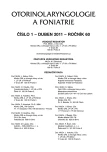Mejzlík J., Chrobok V., Jelínková H.: Lightning Strike-induced Hearing Loss
Authors:
Jan Mejzlík 1,2; Viktor Chrobok 1,2,3; H. Jelínková 1
Authors‘ workplace:
Klinika otorinolaryngologie a chirurgie hlavy a krku, Pardubická krajská nemocnice, a. s., přednosta prof. MUDr. V. Chrobok, CSc., Ph. D.
1; Katedra klinických oborů Fakulty zdravotnických studií Univerzity Pardubice, vedoucí doc. MUDr. K. Havlíček, CSc.
2; Katedra válečné chirurgie, Fakulta vojenského zdravotnictví, Univerzita obrany, Hradec Králové, vedoucí katedry doc. MUDr. L. Klein, CSc.
3
Published in:
Otorinolaryngol Foniatr, 60, 2011, No. 1, pp. 46-50.
Category:
Case Reports
Overview
Lightning strike induces hearing loss in three different ways:
blast injury, burns and electromechanical disintegration of cell membranes. Each of these three types of pathophysiological processes is described and discussed in this case report.
A fifty year old lady was struck by lightning when using a wired phone. The main complaints were hearing impairment, tinnitus, double vision, dizziness, temporary facial nerve palsy, sensory deficit of the left face and right upper extremity. Conservative treatment was started immediately: antibiotics, corticosteroids, vitamin B 12 and Agapurin. After four months a left side myringoplasty was performed. However, more than one year after the injury she still suffers from headaches, tinnitus, balance dysfunction and loss of concentration. Despite the rarity of lightning induced hearing impairment, the basics of treatment should be generally known.
Key words:
lightning strike, telephone, ear, lightning injury.
Sources
1. Andrews, C. J., Darveniza, M.: Telephone-mediated lightning injury: an Australian survey. The Journal of Trauma, roč. 29, 1989, č. 5, s. 665-671.
2. Cooper, M. A.: Lightning injuries. [on line], 2009-12-06 [cit. 2009-11-20]. Dostupné na WWW: <http://emedicine.medscape.com/article/770642-overview>.
3. Hybášek, I.: Otolaryngologie. 1. vyd., Praha, Státní zdravotnické nakladatelství, 1966, s. 134.
4. Jones, D. T. a spol.: Lightning and its effects on the auditory system. Laryngoscope, roč. 101, 1991, č. 8, s. 830-834.
5. Lightning Safety. National Oceanic and Athmospheric Administration (NOAA) [on line]. [cit. 2009-11-20]. Dostupné na WWW: <http://www.lightningsafety.noaa.gov>.
6. Ninger, F.: Porucha ústroje sluchového po poranění bleskem. Časopis lékařů českých, roč. 64, 1925, č. 7, s. 258-259.
7. Offiah, C., Heran, M., Graeb, D.: Lightning strike: a rare cause of bilateral ossicular disruption. American Journal of Neuroradiology, roč. 28, 2007, č. 5, s. 974-975.
8. Ozgun, B., Castillo, M.: Basal ganglia hemorrhage related to lightning strike. American Journal of Neuroradiology, roč. 16, 1995, č. 6, s. 1370-1371.
9. Pellant, A. sen.: Těžké poruchy centrálního a sluchového ústrojí po úrazu bleskem. Časopis lékařů českých, roč. 83, 1944, č. 15, s. 439-441.
Labels
Audiology Paediatric ENT ENT (Otorhinolaryngology)Article was published in
Otorhinolaryngology and Phoniatrics

2011 Issue 1
Most read in this issue
- Lipový B., Řihová H., Kaloudová Y., Jonášek M., Suchánek I., Gregorová N., Brychta P.: Inhalation Trauma – History, Present and Future
- Krempaská S., Kovaľ J. : Complications after Eardrum Membrane Reconstruction
- Dytrych P., Katra R., Jurovčík M., Karmanová D., Šnajdauf J., Kabelka Z.: Laryngotracheoesophageal Cleft
- Hajtmanová E., Hajtman A., Kinclová I., Muríň P., Lietava P., Hajtman A., Péč M.: Percutaneous Endoscopic Gastrostomy in the Therapy of Patients with Advanced Head and Neck Tumors
